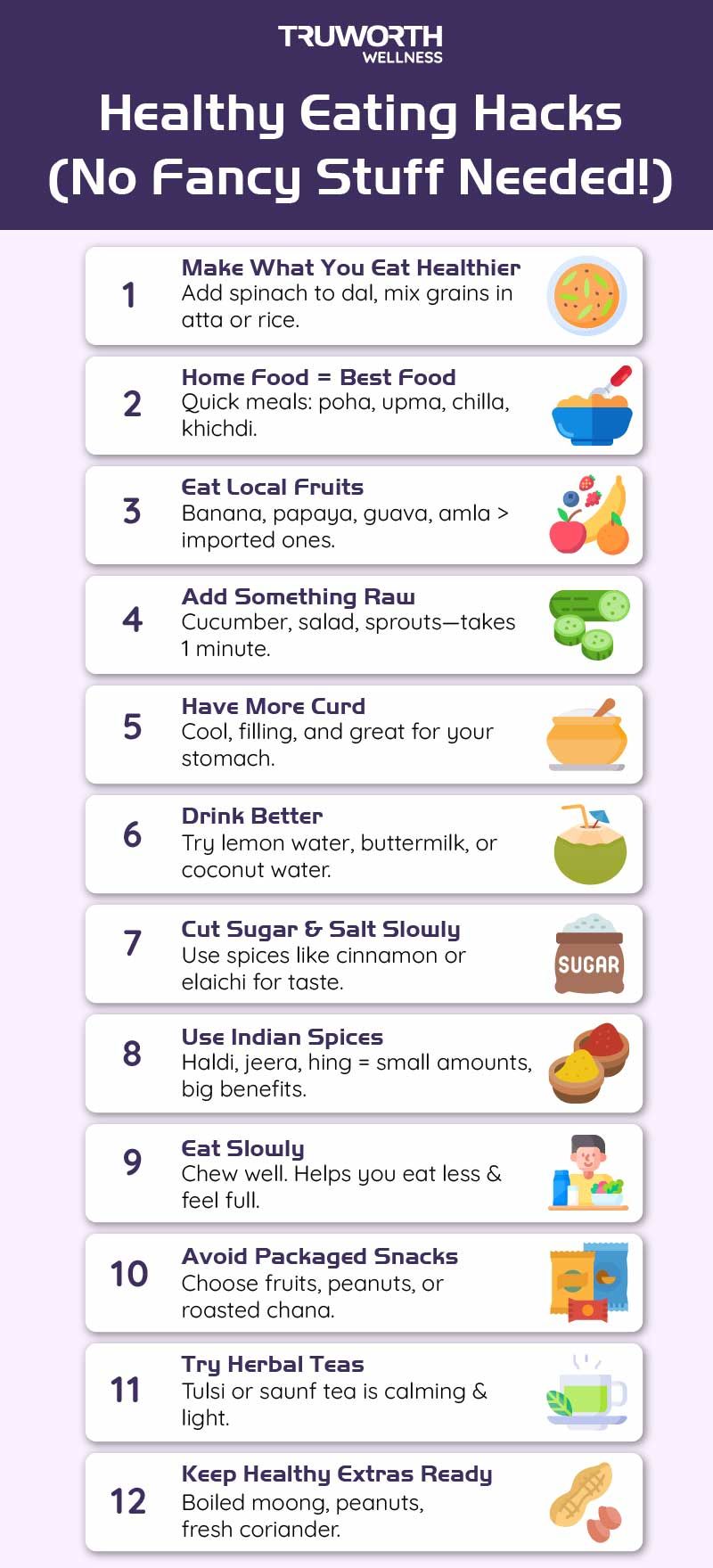Healthy Eating Hacks You Can Try Today (No Fancy Ingredients)

We’ve all heard that healthy eating requires fancy smoothies, exotic berries, or expensive powders. But the truth? You don’t need chia seeds or quinoa to eat well. Most Indian kitchens already have everything you need to start eating healthier, without burning a hole in your wallet or running to gourmet stores.
Healthy eating isn’t about perfection. It’s about small, practical changes you can stick with. If you’re looking to make your meals better today, without turning your lifestyle upside down, these smart food hacks will get you started.
Also Read: Your Guide To Healthy Eating Habits

1. Start with What You Already Eat
You don’t need to change your entire diet. Just upgrade what’s already on your plate.
Eat rotis? Add a spoonful of sattu or bajra to the atta for more fiber.
Make rice regularly? Use a mix of brown rice and white, or try hand-pounded rice.
Have dal every day? Add chopped spinach or methi to it.
🔁 Tiny tweaks = big nutritional boosts.
2. Cook More, Order Less
Yes, home food is almost always healthier. But it doesn’t have to be elaborate. Think:
- One-pot khichdi
- Vegetable upma
- Poha with peanuts and lemon
- Besan chilla with curd
These are low-effort, high-nutrition meals that you can whip up in 15–20 minutes—no sauces, no chemicals—just whole ingredients.
3. Use Local, Seasonal Fruits and Veggies
Forget imported avocados or blueberries. Go local.
- Papaya aids digestion.
- Amla is richer in Vitamin C than oranges.
- Mangoes, jamun, guava, coconut, banana—these are local superfoods!
They’re cheaper, fresher, and more suited to our climate and body needs.
4. Add One Raw Element to Each Meal
Your meal doesn’t have to be perfect, but if you add something raw, you’re already doing great.
- A few slices of cucumber
- A tomato salad with lemon and salt
- Grated carrot with mustard seeds
- A handful of soaked peanuts or sprouts
These take less than a minute to prep and add color, crunch, and nutrients to your plate.
5. Curd Is Your Best Friend
Probiotic-rich, cooling, and satisfying, curd is an underrated powerhouse.
- Have it with your paratha
- Add it to rice with mustard seeds and curry leaves
- Make it into a raita with cucumber or beetroot
Even a plain bowl of curd with a pinch of rock salt is great for gut health.

6. Hydrate Smarter
Drinking water is important, but how you drink it matters too.
- Start your day with warm water + jeera or lemon
- Sip water throughout the day instead of gulping
- Have buttermilk or coconut water instead of cola
- Add mint, cucumber, or tulsi to water for a natural detox feel
7. Cut Back on Salt & Sugar—Slowly
You don’t need to stop suddenly. Just reduce a pinch each week.
- Replace sugary chai with elaichi chai
- Cut the sugar in halwa by half and add more dry fruits
- Use spices like cinnamon or nutmeg for natural sweetness
- Your taste buds will adjust in 2–3 weeks—promise!
8. Use Indian Super Spices
Haldi, jeera, ajwain, hing, curry leaves, methi seeds—they’re not just for taste.
These kitchen staples are packed with medicinal properties. Just a pinch here and there helps:
- Haldi = anti-inflammatory
- Jeera = good for digestion
- Hing = great for bloating
- Methi = balances blood sugar
So the next time you cook, think of spices as nutrition, not just flavor.
9. Eat Slower, Not Less
Here’s a weight-loss trick no one talks about: chew slowly. Eating fast makes you overeat.
- Sit down to eat (not while scrolling)
- Chew 20 times before swallowing
- Put your spoon down between bites
This helps your brain catch up with your stomach and prevents bloating and heaviness.
10. Choose Real over Packaged
If it’s in a packet, pause. Even if it says "high protein" or "baked, not fried."
Instead of packaged snacks:
- Have roasted chana, makhana, or peanuts
- Munch on fruit with black salt
- Eat a cube of jaggery after lunch instead of dessert
Natural doesn’t need an ingredients list. That’s the best kind of nutrition.
11. Switch to Herbal or Spiced Teas
If you’re a tea or coffee lover, try this:
- Replace 1 cup with tulsi tea, saunf tea, or ginger-infused water
- Add spices like cinnamon or dry ginger to regular chai
- Try warm water + honey after meals for digestion
- Herbal teas support immunity, calm digestion, and don’t spike caffeine levels.
12. Keep Healthy Add-Ons Ready
Some things, when prepped ahead, make healthy eating effortless:
- Boiled moong or chana
- Roasted peanuts
- Washed curry leaves, coriander, or spinach
- Dry-roasted seeds (flax, sesame, pumpkin)
Sprinkle them on anything—dal, salad, curd, sabzi—and suddenly your food is more filling and nutrient-dense.
Also Read: Tips To Encourage Healthy Eating In Your Workplace Wellness Program
Final Thought: Eating Healthy Doesn’t Have to Be Fancy
Healthy eating isn’t about saying no to every indulgence. It’s about making smarter choices with what’s already around you.
You don’t need new groceries—you need a new mindset.
Eat slowly. Eat more real food. Add raw veggies. Cut one biscuit instead of the whole packet. Add seeds instead of skipping meals.
Start small. Stay consistent. The best diet is the one you can follow—even on busy, lazy, or low-energy days.
Weekly Checklist: No-Fancy Grocery Must-Haves
- Curd
- Eggs
- Local fruits (banana, papaya, guava)
- Whole grains (poha, rice, atta)
- Mung, chana, peanuts
- Onion, tomato, carrot, cucumber
- Haldi, jeera, methi, hing, cinnamon
- Lemon, coriander, curry leaves
